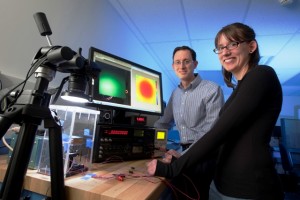Katheryn Yoder ’13 (Sun Prairie, Wis.) is helping develop technology that one day could be found in the computers, cell phones, and televisions we use every day.
The mechanical engineering major is working with Daniel Sabatino, assistant professor of mechanical engineering, on evaluating a new product for local company Minteq International Inc., located on 13th Street in Easton. PYROID® HT Pyrolytic Graphite is a powerful material solution in the battle against heat generated in state-of-the-art electronic circuits and devices.

Daniel Sabatino, assistant professor of mechanical engineering, and Katheryn Yoder ‘13 work in Acopian Engineering Center.
While materials like copper and aluminum are often used to keep electronics cool, they can be heavy and expensive. PYROID® HT Pyrolytic Graphite is lighter and conducts heat significantly better, potentially allowing for smaller or more powerful electronics.
Sabatino and Yoder are responsible for assessing the effectiveness of the product when it is applied in a variety of ways to an array of electronics. They do this through a measurement technique that makes use of material similar to that contained in mood rings: It changes color based on temperature. When sprayed onto electronics like a coat of paint, the material enables Sabatino and Yoder to determine how well PYROID® HT Pyrolytic Graphite keeps the electronics cool.
“This is not an academic exercise. This is real product research,” Sabatino says. “They were looking for a capability that they don’t have and turned to the College, and the students are playing a big role in providing that capability.”
Yoder, who began working on the project this summer through Lafayette’s EXCEL Scholars undergraduate research program, has enjoyed the excitement of gathering new information from the experiments she conducts. A big part of the experience, too, has been grasping the various challenges one faces when creating a product.
“I’ve learned a lot more goes into a product besides what design achieves the best performance,” says Yoder, who plans to attain a Ph.D. in aerospace engineering after graduation. “I hadn’t realized things like manufacturing costs and production capabilities are just as important, not to mention how well it would compete with what’s already on the market.”
Sabatino says that his relationship with Yoder is similar to that between a professor and a graduate student. “She was really allowed the freedom and responsibility to come up with some of the methodology on her own, and then I would look at it and refine it with her,” he says. “But she has earned a lot of responsibility here.”
